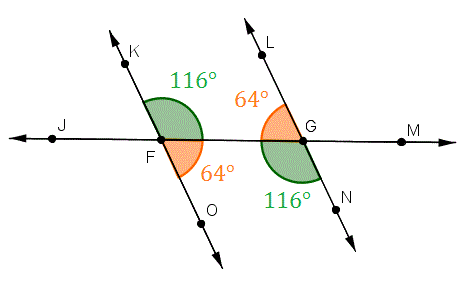9.3 KiB
Unit 4: Trigonometry
Angle Theorems
Transversal Parallel Line Theorems(TPT)- Alternate Angles are Equal
(Z-Pattern)
- Corresponding Angles Equal
(F-Pattern)
- Interior Angles add up to 180
(C-Pattern)
- Alternate Angles are Equal
Supplementary Angle Theorem(SAT)
When two angles add up to 180 degrees

Opposite Angle Theorem (OAT)(OAT)
Two lines intersect, two angles form opposite. They have equal measures

Complementary Angle Theorem(CAT)
The sum of two angles that add up to 90 degrees

Angle Sum of a Triangle Theorem(ASTT)
The sum of the three interior angles of any triangle is 180 degrees

Exterior Angle Theorem(EAT)
- The measure of an exterior angle is equal to the sum of the measures of the opposite interior angles
-
Isosceles Triangle Theorem(ITT)
The base angles in any isosceles triangle are equal

Sum of The Interior Angle of a Polygon
The sum of the interioir angles of any polygon is
180(n-2)or180n - 360, wherenis the number of sides of the polygon
Exterior Angles of a Convex Polygon
The sum of the exterior angle of any convex polygon is always
360 degrees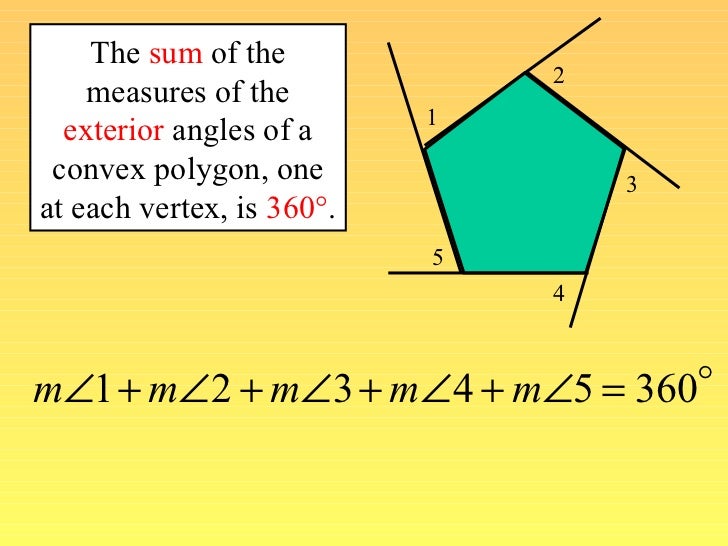
Congruency
Congruent: Same size and shape
Side-Side-Side (SSS)
If three sides of a triangle are respectively equal to the three sides of another triangle, then the triangles are congruent
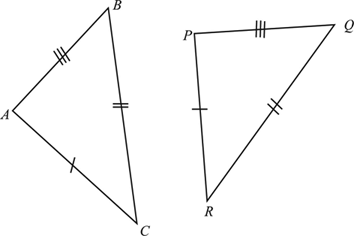
Side-Angle-Side (SAS)
If two sides and the contained angle of a triangle are respectively equal to two sides and the contained angle of another triangle, then the triangles are congruent.

Angle-Side-Angle (ASA)
If two angles and the contained side of a triangle are respectively equal to two angles and the contained side of another triangle, then the triangles are congruent.
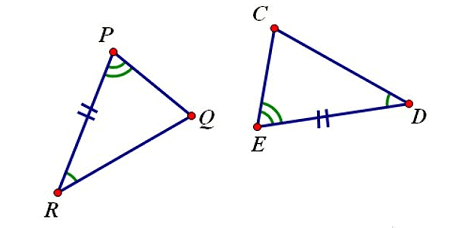
Similar Triangles
Similar: Same shape but different sizes (one is an
enlargement of the other)
Properties
Lets say we have \(`\triangle ABC \sim \triangle DEF`\) 1. Corresponding angles are equal - \(`\angle A = \angle D`\) - \(`\angle B = \angle E`\) - \(`\angle C = \angle F`\)
- Corresponding side are proportional.
- \(`\dfrac{AB}{DE} = \dfrac{AC}{DF} = \dfrac{BC}{EF}`\)
- Proportional Area
- Let \(`k`\) be the scale factor, when concerning for triangle area, if the triangle area can be defined as \(`\dfrac{bh}{2}`\), then by using the smaller triangles side lengths our big triangle’s area is equal to \(`\dfrac{k^2bh}{2}`\). Similar equations and agruments can be dervied from this
Side-Side-Side similarity (RRR \(`\sim`\))
Three pairs of corresponding sides are in the same ratio
Side-Angle-Side similarity (RAR \(`\sim`\))
Two pairs of corresponding sides are proportional and the contained angle are equal.

Angle-Angle similarity (AA \(`\sim`\))
Two pairs of corresponding angles are equal. In the diagram below, we can solve for the missing angle using Angle Sum Of A Triangle Theorem (ASTT) and see that those 2 triangle’s angles are equal.
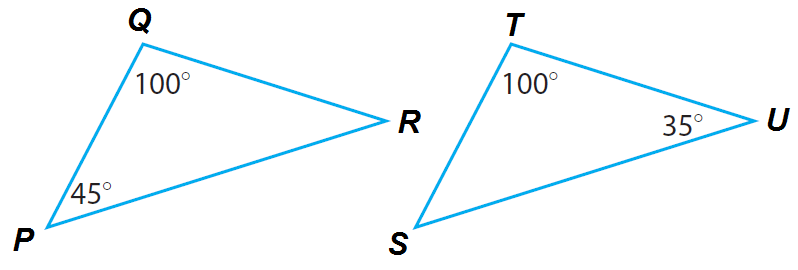
Primary Trigonometric Ratios
| Part Of Triangle | Property |
|---|---|
| Hypotenuse | The longest side of the right triangle. it is across the \(`90^o`\) (right angle) |
| Opposite | The side opposite to the reference angle |
| Adjacent | The side next to the reference agnle |
Remember: Primary trigonometric ratios are only used to find the acute angles or sides of a right-angled triangle
SOH CAH TOA
SINE \(`\sin \theta = \dfrac{\text{Opposite}}{\text{Hypotenuse}}`\)
COSINE \(`\cos \theta = \dfrac{\text{Adajacent}}{\text{Hypotenuse}}`\)
TANGENT \(`\tan \theta = \dfrac{\text{Opposite}}{\text{Adajacent}}`\)
Angle Of Elevation And Depression
| Angle of Elevation | Angle of Depression | |
|---|---|---|
| Definition | Angle of Elevation is the angle from the horizontal looking up to some object | Angle of Depression is the angle frorm the horizontal looking down to some object |
| Diagram |  |
 |
We can see that Angle of Elevation = Angle of Depression in the diagram below (Proven using Z-pattern)

Sine Law
In any \(`\triangle ABC`\): \(`\dfrac{\sin A}{a} = \dfrac{\sin B}{b} = \dfrac{\sin C}{c}`\) or \(`\dfrac{a}{\sin A} = \dfrac{b}{\sin B} = \dfrac{c}{\sin C}`\)
We can derive the formula further to get: - \(`\dfrac{\sin A}{\sin B} = \dfrac{a}{b}`\) - \(`\dfrac{\sin A}{\sin C} = \dfrac{a}{c}`\) - \(`\dfrac{\sin B}{\sin C} = \dfrac{b}{c}`\)
Also, for some trigonometry identities: - \(`\tan x = \dfrac{\sin x}{\cos x}`\) - \(`\sin^2 A + \cos^2 A = 1`\)
If you are finding the sides or agnles of an
oblique triangle given 1 side, its opposite angle and one
other side or angle, use the sine law.
Ambiguous Case
The ambiguous case arises in the SSA or (ASS) case of an triangle, when you are given angle-side-side. The sine law calculation may need to give 0, 1, or 2 solutions.
In the ambiguous case, if \(`\angle A, a, b`\) are given, the height of the triangle is \(`h= b\sin A`\)
| Case | If \(`\angle A`\) is acute | Condition | # & Type of triangles possible |
|---|---|---|---|
| 1 | \(`a \lt h`\) | no triangle exists | |
| 2 |  |
\(`a = h`\) | one triangle exists |
| 3 | 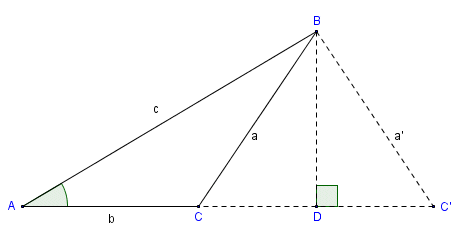 |
\(`h \lt a \lt b`\) | two triangle exist (one acute triangle, one obtuse triangle) |
| 4 |  |
\(`a \ge b`\) | one triangle exists |
| Case | If \(`\angle A`\) is obtuse | Condition | # & Type of triangles possible |
|---|---|---|---|
| 5 |  |
\(`a \le b`\) | no triangles exist |
| 6 |  |
\(`a \gt b`\) | one triangle exists |
Cosine Law
In any \(`\triangle ABC`\), \(`c^2 = a^2 + b^2 - 2ab\cose C`\)
If you are given 3 sides or 2 sides and the contained angle
of an oblique triangle, then use the consine
law
Directions
Bearings: Always start from
North, and goes clockwise
Direction: Start from the first letter (N, E, S, W), and go
that many degrees directly to the second letter (N, E, S, W)
Note: Northeast, southeast, northwest etc. all have 45 degrees to the left or the right from their starting degree (0, 90, 180, 270)
2D Problems
Note: Watch out for the case where you don’t know which side the 2 things (buildings, boats, etc.) are, they can result in 2 answers
3D problems
Note: Use angle theorems to find bearing/direction angle, and to help with the problem in general. Apply sine law, cosine law, and primary trigonometric ratios whenever necessary.
